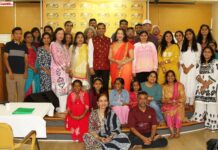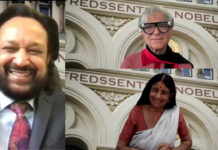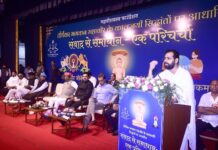
Buddhist art of Kashmir
EVANSTON: The “Collecting Paradise: Buddhist Art of Kashmir and Its Legacies” exhibition here at Mary and Leigh Block Museum of Art, Northwestern University, was officially inaugurated Saturday January 17 with an overview by art historian and curator Robert Linrothe followed by a conversation with Sonya Rhie Quintanilla, Curator of Indian and Southeast Asian Art at Cleveland Museum of Art.
As the 160-seat auditorium could not accommodate the unexpected turnout of over 400, the planned Q&A was cut short and many would-be auditors were redirected to an ad hoc guided tour of the exhibition.
Museum Director Lisa Corrin explained the background of the unique exhibition from conception to implementation, thanking all contributors, sponsors and collaborators in the process. Associate Director of Curatorial Affairs Kathleen Berzock introduced the two speakers.
Linrothe spoke on travel, trade and artistic exchanges across the Himalayas between the seventh and 17th centuries; how and why such works have been collected by Buddhists and by Westerners, and the consequences of their respective approaches. He began by dramatically highlighting, to the amusement of the audience, the exhibition’s binocular vision, by wearing in turn the two hats, red and white respectively, of a Tibetan Lama and of a British colonial officer inspecting an architectural monument.
For the Buddhist patron (donor), artisan and worshipper, a consecrated statue or painting is, more than just an aesthetic representation, a living and transformative presence. He detailed how Western collectors, including the pioneering Italian Orientalist Giuseppe Tucci, impelled by profane motivations, deliberately deceived, bribed and extorted these artifacts from the trusting natives.
Pre-Islamic Kashmir exercised a powerful religio-cultural influence over its surrounding regions, even well into Central Asia. The ethnically distinct inhabitants of the Western Himalayas voluntarily orientated themselves toward Kashmir and avidly collected its Buddhist art by commission works or inviting artists from the Valley.
Originally influenced by Kashmir via Ladakh, etc, Tibet began to retransmit these received and adapted styles back to the Western Himalayas when the latter region was cut off culturally from the Islamized Valley after the 14th century. The original legacy was, however, so persistent that elements of the Kashmiri style, missing in Tibet, resurfaced during the post-15th century renaissance of Buddhism in the Western Himalayas.
The two panelists juxtaposed sculptures and illustrations to trace the influence of Kashmir style, duly contrasted with Central Tibetan style, to show how the Western Himalaya remained faithful to more ancient Kashmir model. They did so especially by examining the finer details of three objects featured in the exhibition. The extraordinary workmanship of the royal Buddha flanked by twin-stupas emerging from the lotus-lake, datable to 714 C.E., is the centerpiece and showstopper of the exhibition.
It retains echoes of Greco-Hellenic style that early Kashmir art had inherited from Gandhara (modern Afghanistan-Pakistan). The same influence is recognizable in the rare sculpture, from Cleveland Museum, juxtaposing three representations of the fasting Buddha, his network of veins exposed in fine detail. Surrounded by scoffers and tormentors, he is shown cringing dejectedly on the left, steadfast in meditation in the middle, and finally accepting a bowl of milk from a village girl to attain Enlightenment through the Middle Way. Their last exhibit was a 15th C Western Himalayan painting of Manjushri from the Art Institute that is stylistically distinct from his representations both in India and Tibet.
Despite their misappropriated artifacts ending up in foreign museums, the contemporary monks are becoming historically aware and eager to learn from Western art historians; monasteries are starting to produce catalogs based on modern scholarship. But how to handle the growing and complex issues of repatriation remains an open question, amply discussed during Linrothe’s two-hour guided tour of “Collecting Paradise” Jan. 28.
Linrothe also underlined the irony of the Kashmir now being a zone of conflict between what are perceived to be external powers. During the Jan. 28 tour, Linrothe clarified that with the Islamized Valley orienting itself more toward Persian religio-cultural models the Western Himalaya was henceforth culturally cut off.
The magnificent sculptured image of the Shaiva goddess Kashmira, embodiment of this paradise on earth so acclaimed subsequently by the celebrated Sufi poet Amir Khusru, was revered by both Hindus and Buddhists. Its easily overlooked consecration inscription is not in the Sharada script, native to Kashmir, but in Tibetan.
The discerning visitor may well come away with the conviction that “Collecting Paradise” does not simply celebrate the legacy of the fluid religio-cultural identities of the past but also thereby offers a tangible roadmap for reconstructing the subcontinent’s possible future.
Elizabeth Visuvalingam






